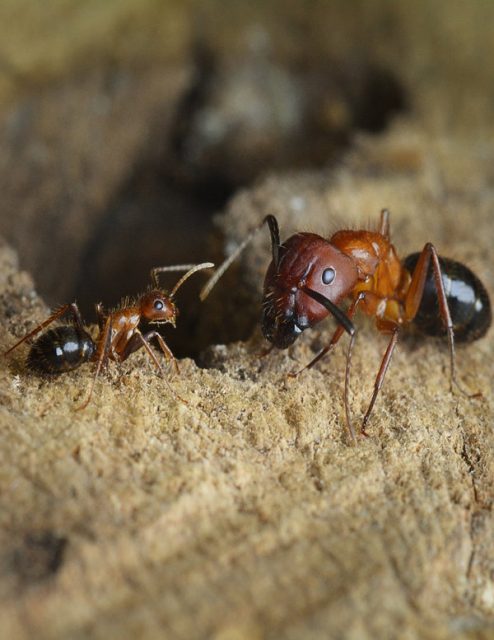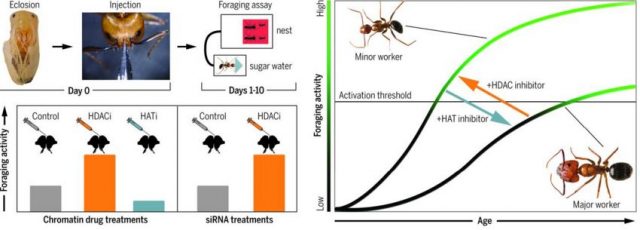Changing the way of life

In multicellular organisms, embryonic stem cells develop into any of the different cell types that will form the adult, and along the development, they silence or activate different parts of the genome, giving rise to distinct cell identities, which are maintained throughout adult life by epigenetic mechanisms. A similar procedure may be at work at the multi-organism level in the ants. The colony would be analogous to the adult organism, with different types of individuals (i.e. castes) originated from genetically identical eggs and keeping particular morphologies and behaviors through epigenetic influences.
The caste system of insects enables eusociality, the colonial division of labor between different groups of individuals and it is a key evolutionary adaptation of these insects. The most fundamental examples of division of labor involve the differentiation of individuals into sterile (worker) and reproductive (queen) castes. In addition, workers often express a variety of specialized behaviors –subcastes– depending on age, body size, or both. However, there is a poor understanding of the molecular regulation of caste-specific behavior and the principles underlying division of labor. Studies in different species of eusocial insects such as the honeybee Apis mellifera and the carpenter ant Camponotus floridanus suggest that epigenetic processes, including DNA methylation and histone posttranslational modifications, play key roles in developing those behavioral particularities that are the main difference among subcastes.
A series of polyphenisms determine whether a particular larva develops into a queen, a worker or a soldier. Interestingly, the establishment and maintenance of individual identity in the ant colony may be done by unique patterns of histone posttranslational changes. One of the main modifications is acetylation of lysine residues in the histone, a procedure regulated by an acetylase named CBP (CREB-binding protein). Acetylation can be reversed by different enzymes named histone deacetylases (HDACs).
Royal jelly is a secretion from the glands in the hypopharynx of worker bees. It is used in the nutrition of larvae and it is secreted and fed to all larvae in the colony, regardless of sex or caste as well as adult queens. When a new queen is needed in the colony, because the old one is either weakening or dead, the workers choose several larvae and feed them with copious amounts of royal jelly in specially constructed queen cells. This type of feeding triggers the development of queen morphology, including the fully developed ovaries needed to lay eggs. Interestingly, the fatty acid 10-HAD, a functional histone deacetylase inhibitor, is a major component of royal jelly.
The behavior of castes is adapted to their labors. As an example, among Florida carpenter ants Camponotus floridanus, there are two types of workers, the so-called majors, commonly known as soldiers, and the smaller minors that act as foragers and scouts, commonly known as workers. Researchers are not entirely sure what triggers larvae to become ones or the others. Behaviors are also substantially different: scouts are the first ants to leave a nest, discover a source of food, and return to the nest with this food and information, recruiting there additional ants to forage whereas the majors aggressively guard the colony, stay in the nest and do not forage. Simola and coworkers found that these different behaviors are regulated by histone acetylation and deacetylation likely catalyzed by CBP and HDACs, respectively. 1

The most surprising result has been that the caste-adjudication system is programmed in the insect development but it can be reprogramed in the first days of life. Treatments with small-molecule inhibitors of deacetylases enhanced foraging and scouting. The gain of function was suppressed with an inhibitor of CBP. Transcriptome and chromatin analysis in brains of scouting minors treated with pharmacological HDAC and CBP inhibitors revealed hundreds of genes linked to hyperacetylated regions targeted by CBP. Majors rarely forage, but an injection of HDAC inhibitor or small interfering RNAs against the HDAC-encoding gene into young major brains was sufficient to induce and sustain minor-like foraging and scouting for up to 50 days. Strikingly, co-injection of CBP inhibitor suppressed HDAC inhibitor-induced foraging and scouting in majors. Thus, caste-specific foraging and scouting behaviors are likely regulated epigenetically by the balance between CBP-mediated acetylation and HDAC-mediated deacetylation of histones in the ant central brain.
These data demonstrate the epigenome as a likely mediator underlying caste-based division of labor in ants. These are long-term permanent changes but this behavior could be altered through a histone-modification window during the first few days of life. These results suggest that behavioral plasticity in animals may be regulated in an epigenetic manner via histone modification and this regulation can be manipulated by pharmacological and genetic tools that target chromatin regulatory enzymes. In this way, it is possible to stimulate, inhibit, and reprogram behavior. Epigenetic control over new generations of ants may allow colonies to adapt dynamically to drastic ecological changes within their lifetime, for example, in response to prolonged famine or colony predation, which can alter caste ratios.
References
- Simola DF, Graham RJ, Brady CM, Enzmann BL, Desplan C, Ray A, Zwiebel LJ, Bonasio R, Reinberg D, Liebig J, Berger SL (2016) Epigenetic (re)programming of caste-specific behavior in the ant Camponotus floridanus. Science DOI: 10.1126/science.aac6633 ↩
2 comments
This is trully fascinating! I wonder whether the brain injections may also affect normal behavioral processing in the ants – just like a traumatic event for us humans. Also. I wonder whether does injections also change the morphology of the ants?
It does not change the morphology of the ants. The research group has centered on the main behavioral difference between both castes: foraging or protecting the nest. Other differences are not so clearly marked and the distinction would be subtle. Thanks for your comment!